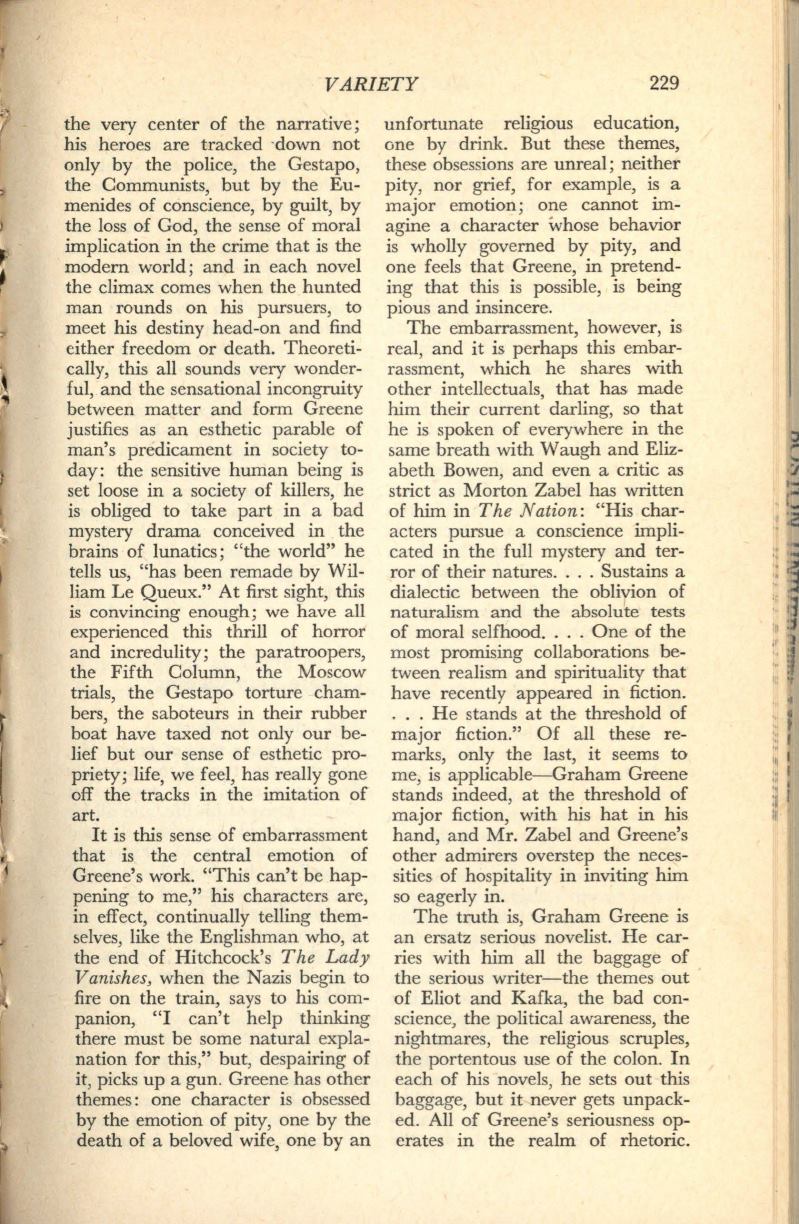
,
VARIETY
229
the very center of the narrative;
his heroes are tracked ·down not
only by the police, the Gestapo,
the Communists, but by the Eu–
menides of conscience, by guilt, by
the loss of God, the sense of moral
implication in the crime that is the
modern world; and in each novel
the climax comes when the hunted
man rounds on his pursuers, to
meet his destiny head-on and find
either freedom or death. Theoreti–
cally, this all sounds very wonder–
ful, and the sensational incongruity
between matter and form Greene
justifies as an esthetic parable of
man's predicament in society to–
day: the sensitive human being is
set loose in a society of killers, he
is obliged to take part in a bad
mystery drama conceived in .the
brains of lunatics; "the world" he
tells us, "has been remade by Wil–
liam Le Queux." At first sight, this
is convincing enough; we have all
experienced this thrill of horror
and incredulity; the paratroopers,
the Fifth Column, the Moscow
trials, the Gestapo torture cham–
bers, the saboteurs in their rubber
boat have taxed not only our be–
lief but our sense of esthetic pro–
priety; life, we feel, has really gone
off the tracks in the imitation of
art.
It is this sense of embarrassment
that is the central emotion of
Greene's work. "This can't be hap–
pening to me," his characters are,
in effect, continually telling them–
selves, like the Englishman who, at
the end of Hitchcock's
The
Lady
Vanishes,
when the Nazis begin to
fire on the train, says to his com–
panion, "I can't help thinking
there must be some natural expla–
nation for this," but, despairing of
it, picks up a gun. Greene has other
themes: one character is obsessed
by the emotion of pity, one by the
death of a beloved wife, one by an
unfortunate religious education,
one by drink. But these themes,
these obsessions are unreal; neither
pity, nor grief, for example,
is
a
major emotion; one cannot im–
agine a character whose behavior
is wholly governed by pity, and
one feels that Greene, in pretend–
ing that this is possible, is being
pious and insincere.
The embarrassment, however, is
real, and it is perhaps this embar–
rassment, which he shares with
other intellectuals, that has made
him their current darling, so that
he is spoken of everywhere in the
same breath with Waugh and Eliz–
abeth Bowen, and even a critic as
strict as Morton Zabel has written
of him in
The Nation:
"His char–
acters pursue a conscience impli–
cated in the full mystery and ter–
ror of their natures.... Sustains a
dialectic between the obliyion of
naturalism and the absolute tests
of moral selfhood. . . . One of the
most promising collaborations be–
tween realism and spirituality that
have recently appeared in fiction.
. . . He stands at the threshold of
major fiction." Of all these re–
marks, only the last, it seems to
me, is applicable-Graham Greene
stands indeed, at the threshold of
major fiction, with his hat
in
his
hand, and Mr. Zabel and Greene's
other admirers overstep the neces–
sities of hospitality in inviting
him
so eagerly in.
The truth is, Graham Greene is
an ersatz serious novelist. He car–
ries with him all the baggage of
the serious writer-the themes out
of Eliot and Kafka, the bad con–
science, the political awareness, the
nightmares, the religious scruples,
the portentous use of the colon. In
each of his novels, he sets out this
baggage, but it never gets unpack–
ed. All of Greene's seriousness op–
erates in the realm of rhetoric.


